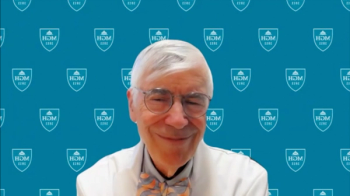
Cholesterol Goals in Primary Cardiovascular Disease Prevention
Peter Salgo, MD: Let’s take a look, now, at some of our goals. There are people whose cholesterols are too high. We define what too high is, and we should, by the way. What is your goal in lipid lowering to decrease cardiovascular risk?
Howard Weintraub, MD: The minimum I want to reduce is 30% to 40%, and the reason for that is vascular biology. You want to make the endothelium (the inner lining of the blood vessel) behave in a matter that’s not permissive for the formation of atherosclerosis, and you’d like the plaque to start changing. If you go less than that, you’re not going to get it. After that, you go for numeric targets. In numeric targets, we see that if you get below 70 mg/dL, you’re going to do better.
Peter Salgo, MD: That’s 70 mg/dL for your LDL?
Howard Weintraub, MD: Exactly. Correct. Now, sometimes if your LDL is 250 mg/dL, you have a long way to go. It’s not going to be so easy to do without one of the newer drugs that’s available. But under 200 mg/dL and with a little bit of cooperation from the patient, you may be able to get to a goal of 70 mg/dL.
Peter Salgo, MD: I want to start out where you started out, which is the percentage reduction. To me, a percentage reduction is suboptimal in this regard. You start out with 300 mg/dL, you’re going to take it down by 30%, and you’re down to 200 mg/dL. That’s not so good. So why don’t you just start with a numerical number from the beginning?
Howard Weintraub, MD: The reason I don’t do this is because a lot of people come into the office in their 20s and 30s, and they are being told by their physician that they need a statin. They’re against starting a statin early, and after a dialogue that more or less says, “No, this is not poison, this is not the dark side, you’ll do okay,” they still want to try to do something on their own. So, I find that you encourage people to try to do things on their own—to diet, to try lifestyle changes. You give them a finite amount of time in which you say, “Look, let’s do this again in 3 months. After that, the deal is over, and if you haven’t got to where you have to go, we’re going to do something.” And you take that number you’ve got and tell them, “You’ve got to get this down to an LDL of below 130 mg/dL for sure, preferably below 100 mg/dL, or you’ve got to get a minimum of a 40% reduction.” If they get anything from their lifestyle, maybe it means 1 medicine rather than 2.
Seth J. Baum, MD: But Howard is really referring to primary prevention.
Howard Weintraub, MD: Right.
Seth J. Baum, MD: And he and I would say, probably, the practice is almost exactly the same as if you had somebody with secondary prevention.
Howard Weintraub, MD: Different story.
Seth J. Baum, MD: It’s a totally different story. In somebody who’s had an infarct, somebody who has familial hypercholesterolemia (FH), or in somebody who’s a much higher risk patient, you want to get that LDL down as low as possible.
Peter Salgo, MD: Secondary prevention. Isn’t that, again, closing the barn door after the horse is gone? Wouldn’t you rather say, “I’m not going to wait for your myocardial infarction, I’m going to give you a statin now”?
Seth J. Baum, MD: Of course, but we don’t have that opportunity.
Peter Salgo, MD: You’re going to pay for that?
Gary L. Johnson, MD, MBA: Absolutely. In my role as a family physician, I practice primary prevention. I start seeing patients, essentially, when they’re born, and try to do the best at preventive medicine that I can. And that’s paid for.
Peter Salgo, MD: Yes, but I can remember the day when the statins were first introduced and they were expensive. If you had an LDL of 130 mg/dL, you didn’t get it unless you were high risk or class 2 prevention. You told the clinicians, “No atorvastatin for your patients because they don’t meet the high-risk category.” That’s changed, right? Were you wrong? Were you wrong back then?
Jennifer Strohecker, PharmD, BCPS: We were wrong back then, yes. The question is, for example, when you have a conversation with your patient who is in their 20s and 30s about starting dietary interventions first, how successful are we?
Howard Weintraub, MD: I’m very successful, but that’s because I talk to people. Most physicians don’t have the luxury of an office visit that’s 20 to 30 minutes long. Most physicians have seen 2 or 3 people in that time, and you don’t get much of a chance to talk to them.
Peter Salgo, MD: Give me a definition. When you say, “I’m very successful.....”
Howard Weintraub, MD: Seventy percent to 75%....
Peter Salgo, MD: Seventy-five percent of what?
Howard Weintraub, MD: Of people who change their diet, lose weight, and drop their cholesterol meaningfully and perpetually.
Peter Salgo, MD: All right, so you see a meaningful decrease in LDL cholesterol with diet and exercise—lifestyle changes?
Howard Weintraub, MD: Yes.
Seth J. Baum, MD: In a particular patient population.
Howard Weintraub, MD: In the primary prevention population.
Seth J. Baum, MD: The primary prevention with an LDL elevation that’s not based on FH. Again, that’s a different thing.
Peter Salgo, MD: It’s not going to work there.
Seth J. Baum, MD: Right. I just want to clarify that. And I would say the same, I get the same result.
Peter Salgo, MD: You all were talking about the diet books earlier. The reason there’s so many diet books is they don’t work, and everybody thinks the next diet book is THE diet book. So, what’s different about your patients that it works when the vast majority of Americans can’t even lose 5 pounds?
Howard Weintraub, MD: They come in to me already motivated to try it. They come in, try to not be on a medicine, and they come in wanting to do something. Immediately, I harness that. And the diet that I use is the only one with data—it’s the Mediterranean diet. The Mediterranean diet has data on events, and it’s followable, and it’s palatable. You don’t have to eat birdseed and cardboard and never drink alcohol. I think it’s something that people can go after.
Peter Salgo, MD: It does work?
Howard Weintraub, MD: Yes.
Peter Salgo, MD: All right. So, you don’t need the cabbage diet, the pineapple diet, or the eat-only-peas-on-Tuesdays diet—all of which work if you can stick to them. But nobody can stick to them.
Howard Weintraub, MD: I agree with you 100%.
Gary L. Johnson, MD, MBA: I was just going to ask, if 75% success rate is your norm, why is it that we said 80% of the population is not really where they should be?
Howard Weintraub, MD: It’s a selective population.
Gary L. Johnson, MD, MBA: It’s a very selective population.
Howard Weintraub, MD: Right. And other patients come in and say, “Let me get this straight. I can’t go to McDonald’s and Taco Bell and visit the Colonel? I want no part of this.” And they say, “Give me the medicine.” They use the medicines to eat like a pig. And so, we get great looking numbers with expanding waistlines.
Peter Salgo, MD: By the time you get to those patients that you’re recommending lifestyle changes to, a fair number of the other patients have dropped off.
Howard Weintraub, MD: Right.
Peter Salgo, MD: The folks who can’t do it, won’t do it. Is it a majority that drop off or a minority?
Howard Weintraub, MD: About two-thirds.
Peter Salgo, MD: A majority, that’s a lot. So, for you to sit there and tell these guys, “I’m going to do this with diet and exercise,” 66% aren’t going to get it done. Is that what you heard?
Gary L. Johnson, MD, MBA: That’s what I heard.
Peter Salgo, MD: Is that what you heard?
Jennifer Strohecker, PharmD, BCPS: That’s what I heard.
Howard Weintraub, MD: Yes, but the point of the matter is you can still make a difference with prevention in people who are going to need drugs by doing diet and exercise, so that you don’t have them entering the medicine with an LDL of 190 mg/dL. They’re entering with a level of 130 mg/DL. They need less medicine, their goals are more attainable. When you start giving the patient more than 1 drug, they immediately start freaking out. What’s the adherence to statins? After 6 months, how many people don’t refill? A lot.
Newsletter
Stay ahead of policy, cost, and value—subscribe to AJMC for expert insights at the intersection of clinical care and health economics.



























































